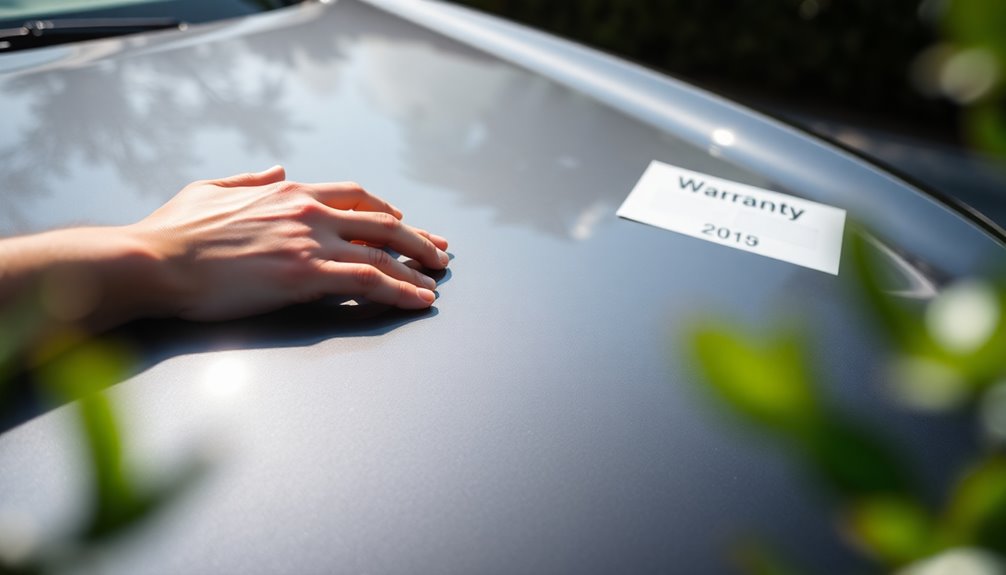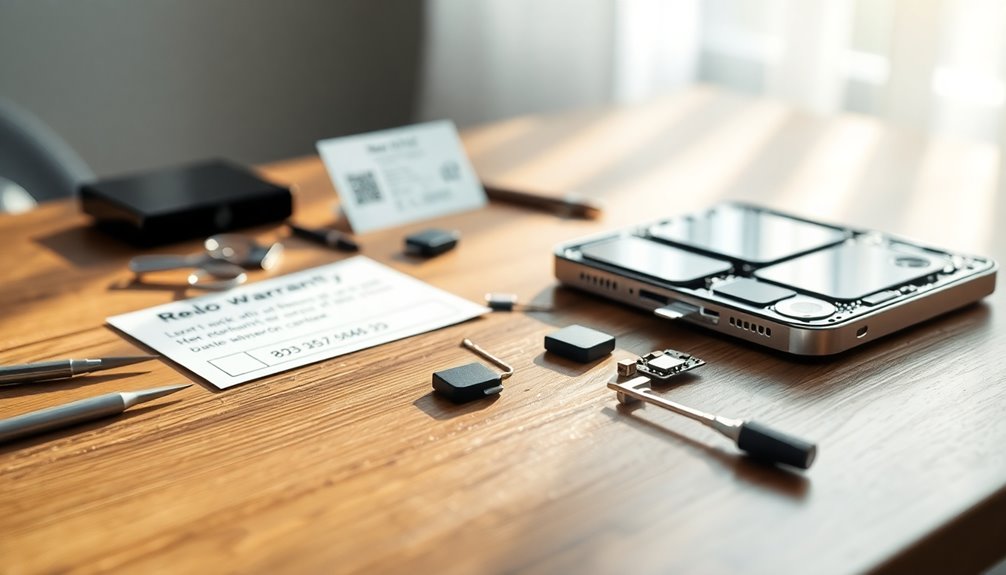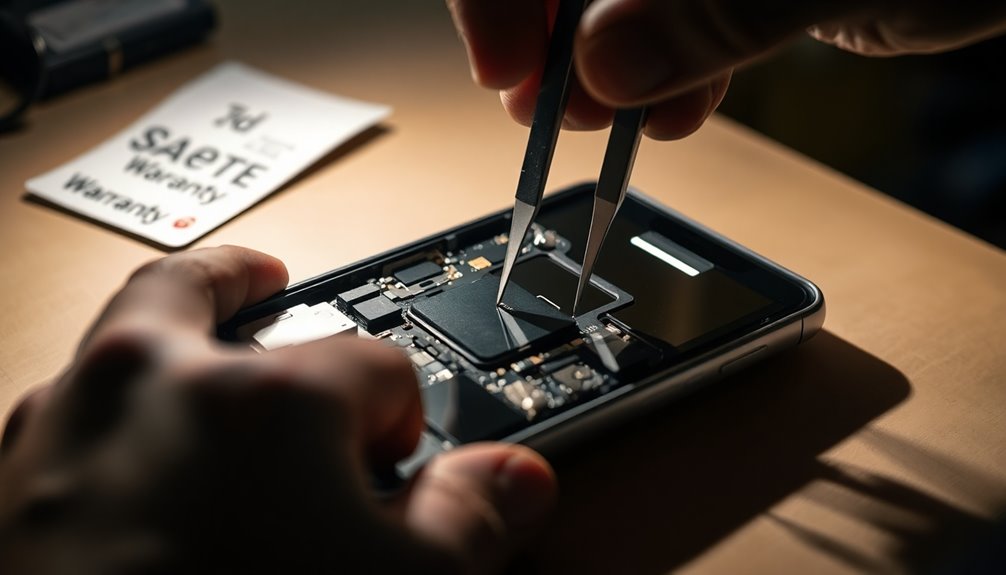Reconditioning can void your warranty if it's done improperly or by unauthorized services. Most warranties require that repairs are conducted by certified technicians to maintain coverage. If the manufacturer finds that reconditioning caused defects or didn't follow their guidelines, they can deny claims. However, under the Magnuson-Moss Act, modifications alone don't automatically void warranties; manufacturers must prove harm. It's crucial to keep documentation of any maintenance or repairs you get. This not only supports your claims but also protects your rights as a consumer. Want to discover more about how reconditioning affects warranties?
Key Takeaways
- Reconditioning typically involves repairs that can void warranties if performed by unauthorized service providers or in ways not approved by the manufacturer.
- Manufacturer warranties often stipulate that modifications or repairs need to be done by certified technicians to maintain coverage.
- The Magnuson-Moss Act protects consumers, allowing for repairs without automatically voiding warranties, unless modifications directly cause defects.
- Documentation of reconditioning and adherence to manufacturer guidelines is crucial for maintaining warranty validity.
- Always check warranty terms before reconditioning to understand potential risks and specific conditions that may lead to voiding coverage.
Understanding Warranty Basics

When you buy a product, understanding warranties is crucial. A warranty is a promise from the manufacturer or seller about the product's condition. It assures you that what you're purchasing works as advertised, providing repairs, refunds, or exchanges if it fails. Warranties usually have a specified duration and come with exceptions limiting when they apply.
There are two main types of warranties: expressed and implied. Expressed warranties detail the product's quality and performance, while implied warranties assume the product will function as expected. Additionally, under the Uniform Commercial Code, there is an implied warranty of merchantability to ensure products meet basic standards.
Full warranties promise to repair or replace the product at no charge during the warranty period, adhering to the Magnuson-Moss Warranty Act standards. In contrast, limited warranties specify what's covered and may have more restrictions.
Warranties outline the terms for repairs or exchanges, but you must meet certain responsibilities, like proper maintenance. Remember, manufacturers aren't obligated to assist once the warranty period expires.
It's essential to read the warranty document thoroughly before purchasing to understand whether it's full or limited and any duties you must fulfill. Knowing these basics helps you make informed decisions and protect your investment.
Legal Protections for Consumers

Legal protections for consumers are essential in ensuring you can enjoy the benefits of your purchases without fear of losing warranty coverage. The Magnuson-Moss Warranty Act safeguards your right to repair and modify products without automatically voiding warranties. Manufacturers can't just void your warranty for using aftermarket parts or third-party services; they must prove that your modification caused any defect. This means that if you perform a repair, the burden of proof lies with the manufacturer to show that the modification led to the issue, which supports your consumer rights.
The FTC backs you up, clarifying that "warranty void if removed" stickers can violate federal law if they hinder necessary maintenance or repairs. You have the right to open and repair your devices, and you can use non-original parts without losing warranty protection. If a product doesn't meet the warranty standards, you can request a refund or replacement.
Keep in mind that documenting your repairs is crucial. This documentation can help you in case of any disputes, showing that your actions didn't cause the issue.
While you're responsible for any damage caused during repairs, manufacturers must follow specific guidelines if they want to deny warranty coverage for defects caused by unauthorized parts or services. Overall, these protections empower you to make informed decisions about your purchases.
Conditions Leading to Warranty Void

Warranty voidance can happen under several conditions that you should be aware of to protect your investment.
First, unauthorized repairs or modifications can lead to immediate warranty cancellation. If you let non-certified personnel handle repairs or use unapproved service providers, your warranty's validity is compromised. DIY fixes or alterations also generally aren't allowed, and any changes to the product's original configuration can void your coverage.
Accidental negligence is another critical factor. If you drop your device or expose it to liquid, the damage caused by such carelessness typically isn't covered. Moreover, power surges or electrical mishaps due to improper handling can also void your warranty.
Software modifications can be a hidden trap. Jailbreaking or altering the operating system, as well as installing unauthorized software, can jeopardize your warranty. Any changes that affect functionality or security are particularly risky. Additionally, engaging in software modifications can significantly impact the warranty status of your device.
Lastly, failing to follow maintenance guidelines or using unauthorized components can void the warranty. Always adhere to the manufacturer's recommendations and be cautious about geographical limitations to ensure your warranty remains intact.
Stay informed to protect your investment effectively.
Impact of Third-Party Repairs

Using third-party repair services can significantly impact your warranty status and the overall quality of maintenance your device receives. If your manufacturer explicitly states that only authorized service providers can perform repairs, using a third-party service might void your warranty.
While federal laws like the Magnuson Moss Warranty Act prevent companies from voiding warranties solely for using third-party parts, there are exceptions. Companies need to obtain an FTC waiver to enforce specific branded parts, which complicates your repair choices.
Beyond warranty concerns, the quality of repairs can vary significantly. Third-party providers often lack the same level of training and expertise as authorized technicians, leading to subpar repairs that could damage your equipment further. Manufacturers invest in training for authorized service providers to ensure high-quality service and repairs.
Non-standardized processes and inadequate tools can result in incomplete maintenance, leaving potential risks undetected.
While third-party services may offer quicker fixes and potentially lower costs, consider the long-term implications on your device's functionality and your warranty. The convenience of third-party repairs mightn't outweigh the risks of voiding your warranty or compromising your device's integrity.
Always weigh the pros and cons before opting for a third-party provider.
Importance of Documentation

Maintaining accurate documentation is crucial for protecting your rights as a consumer and ensuring you can effectively leverage your warranty. Keeping track of all repairs and maintenance done on your product is essential. These service records can prove you've performed routine maintenance as required by the manufacturer, which is key in case you need to file a warranty claim. Additionally, it's important to remember that merchants must prove any alterations caused the defect to void the warranty.
Don't forget to include dates, types of services, and parts used. Storing receipts and invoices is also important.
Review your warranty document thoroughly to understand what's covered, the duration of the warranty, and any conditions that could void it. Document your compliance with manufacturer guidelines by following recommended maintenance schedules and keeping records that demonstrate any modifications didn't cause defects.
Organize and securely store all warranty-related documents. This includes a record of communications with the manufacturer or dealer about warranty claims.
When needed, having all this documentation readily available can support your claims and help resolve any disputes effectively. By prioritizing documentation, you ensure that your rights are protected and that you can take full advantage of your warranty.
Consumer Rights and Advocacy

Understanding your rights as a consumer is essential in navigating warranty claims and modifications. Under federal law, you have the right to repair or modify your products without automatically voiding the warranty. The Magnuson-Moss Warranty Act protects you by requiring manufacturers to prove that any modification caused a defect to deny coverage. This means you can confidently use aftermarket parts or independent repair services without fear of losing warranty protection.
It's crucial to recognize that "warranty void if removed" stickers may violate federal law if they hinder routine maintenance. The Federal Trade Commission (FTC) actively challenges companies that impose illegal warranty restrictions, ensuring your right to repair is upheld. Companies must clearly inform you about warranty conditions, and they can't enforce unreasonable requirements. Additionally, understanding your rights is particularly important when purchasing refurbished phones from retailers, as they are bound by the Consumer Rights Act 2015 to ensure that goods are of satisfactory quality.
Advocacy groups are pushing for extended consumer rights, promoting durability and repairability in products. You're entitled to options that go beyond the manufacturer's services, including independent repairers.
Frequently Asked Questions
Can I Recondition My Product Without Voiding the Warranty?
You can recondition your product without voiding the warranty, as long as you follow specific guidelines set by the manufacturer.
Make sure you use recommended parts and keep detailed records of your maintenance and repairs. If you adhere to the manufacturer's policies, you should be fine.
However, unauthorized modifications could potentially lead to warranty issues, so it's best to proceed carefully and stay informed about your rights regarding warranty coverage.
What Specific Modifications Are Considered Reconditioning?
When you think about reconditioning, you're looking at significant modifications that restore equipment to its original operating conditions.
This includes rebuilding electromechanical systems, refurbishing components, or upgrading to meet current standards.
It's important to note that simply servicing or replacing parts doesn't count as reconditioning.
If you're planning to modify your equipment, ensure you document everything and follow guidelines to avoid potential issues down the line.
Do All Manufacturers Allow Reconditioning Under Their Warranties?
Not all manufacturers allow reconditioning under their warranties.
Each manufacturer sets its own policies regarding what's covered and the terms for reconditioned products. You should check the warranty documentation to see if reconditioning is permitted and what specific conditions apply.
Some manufacturers might provide separate warranty coverage for reconditioned items, while others may exclude them entirely.
It's essential to understand the terms to avoid any surprises in case of a claim.
How Can I Find Out My Warranty's Specific Reconditioning Rules?
To find out your warranty's specific reconditioning rules, start by reviewing the warranty contract for any clauses about modifications and maintenance.
Check the owner's manual and the manufacturer's website for guidelines. If needed, contact customer service for clarification.
It's also helpful to keep detailed records of all maintenance and repairs, as this documentation can support your case if any questions arise regarding warranty coverage.
Will Reconditioning Affect My Product's Resale Value?
Reconditioning can significantly boost your product's resale value. By enhancing both its aesthetic appeal and mechanical soundness, you attract potential buyers.
Cosmetic improvements like paint correction and upholstery repairs create a great first impression, while addressing mechanical issues ensures reliability. Keeping comprehensive maintenance records further instills buyer confidence.
Conclusion
In conclusion, reconditioning can potentially void your warranty, but it often depends on specific conditions and the manufacturer's policies. To protect your rights, always read the warranty terms carefully and keep thorough documentation of any repairs or modifications. If you're unsure, it's wise to consult with the manufacturer or an expert before proceeding. Staying informed about your consumer rights can help you avoid costly surprises down the road.










